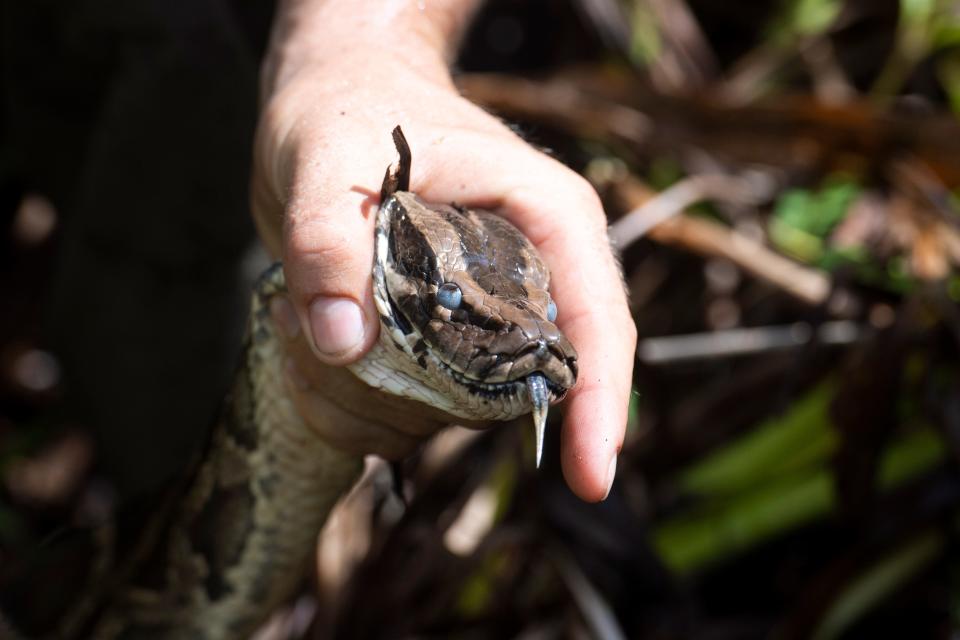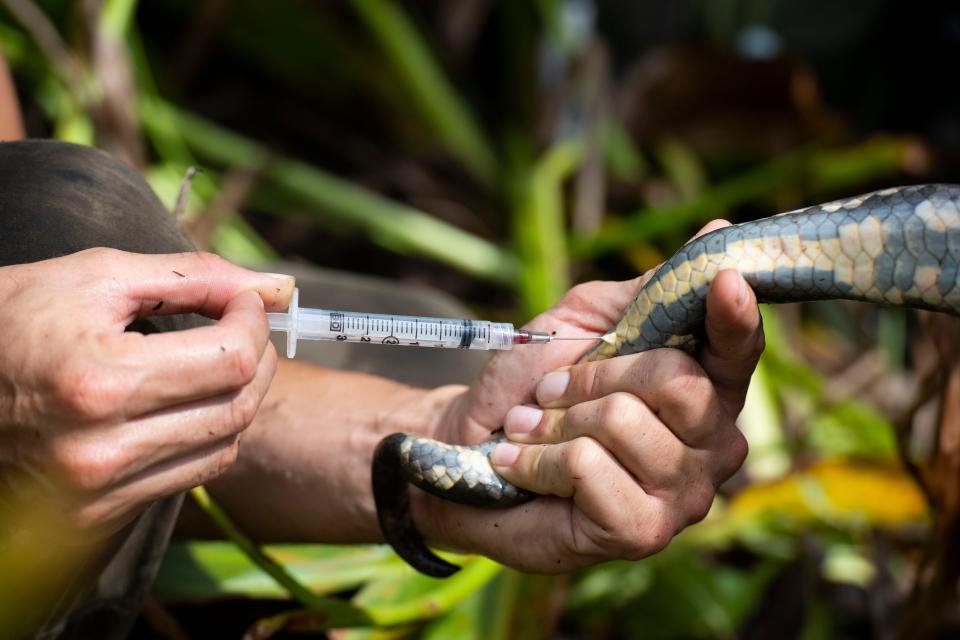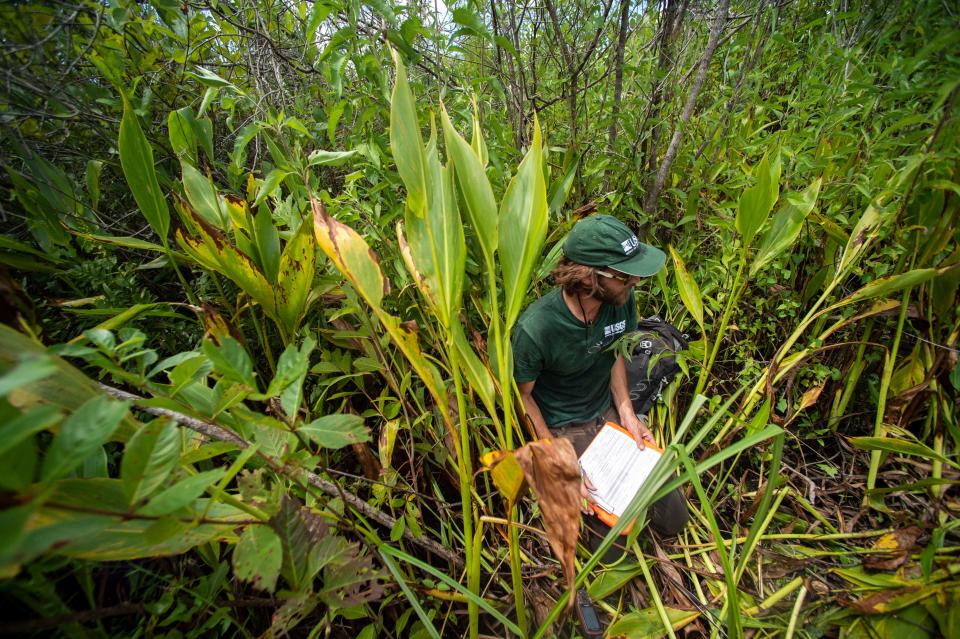Giant snakes in the Florida Everglades: How scientists are using Burmese pythons as spies

OCHOPEE, Fla. — Charlie 5 had no plans to move that hot June morning. The 9-foot-long Burmese python was comfortably nestled in a muddy hollow, well-hidden in a thicket of saw grass and alligator flag in Big Cypress National Preserve.
His tracking device gave him away. He didn't like it, but he had visitors.
"There he is," said Austin Fitzgerald, a biological science technician with the U.S. Geological Survey (USGS), bending down within 18 inches of the steamy muck. "I can just barely see his head."
Using two snake hooks, Fitzgerald and Jillian Josimovich, a biologist with the USGS invasive species science branch, persuaded the reluctant snake to come out of hiding.
It's hard to read a snake's body language, but Charlie 5 — writhing to free himself — clearly wished he had never met Fitzgerald and Josimovich.

Invasive snakes strangle Florida wildlife
The uninvited denizens of South Florida's wildlands, woodlands, marshlands and swamplands have left an indelible — and possibly irreversible — mark on the ecosystem.
First identified in Everglades National Park in 2000, the Southeast Asian apex predator quickly put a stranglehold on Florida's wildlife.
To a python, Florida's rich biodiversity of mammals, birds, reptiles and amphibians is a veritable smorgasbord of delicacies. According to the USGS, a 2012 study in Everglades National Park revealed pythons have contributed to these population declines:
99.3% fewer raccoons
98.9% fewer opossums
87.5% fewer bobcats
Foxes and marsh and cottontail rabbits have "effectively disappeared," the study says.
As pythons eat their way across the Sunshine State's landscape, there is strong evidence Florida's bird, native snake and iconic alligator populations are also suffering.
What predators the python doesn't eat are losing the competition for food, including bobcats and panthers. The hunters are simply too large and too efficient. They are at home in warm, wet, watery climates and can swim, burrow and climb trees.
About the only thing they can't do is fly.
Researchers even believe pythons have swum across the open saltwater of Florida Bay from the Everglades to islands in the Florida Keys.
Super snake:Burmese and Indian pythons crossbred, invaded Florida, study suggests

Giant snakes that expertly hide
A fundamental problem in keeping up with the python's assault on Florida is the snake's ability to remain out of sight, said Matthew McCollister, a resource manager with the National Park Service based at Big Cypress National Preserve in Ochopee.
"The tools that exist today are not sufficient" to locate pythons, he said. "We have got to invest in developing and improving tools."
The key is finding and removing breeding females, he said.
A clever approach underway in Southwest Florida since 2013 has been helping scientists keep tabs on snakes.
The Conservancy of Southwest Florida has been working with various groups — the USGS, National Park Service, James Madison University, zoos in Naples and Miami and Florida Fish and Wildlife Conservation Commission — to develop and assess new ways to curb pythons' proliferation.
When males are discovered crossing a road or slithering along a canal dike, they are caught and taken to a Zoo Miami lab where veterinarian Frank Ridgely, donating his time and facilities, surgically inserts a radio transmitter.
The pythons are released back into the wild to act as spies, hence their nickname "Judas snakes." During the December-through-April breeding season, the males lead researchers to the females.
"The radio transmitter allows you to follow it wherever it goes," Josimovich said. "It emits a pulsating beep. We can go to our animal and potentially remove several other individuals" found in breeding populations called "breeding balls."
Record python: This 17-foot-long snake carrying 73 eggs is now dead

'Breeding balls' of five or six snakes
Breeding balls sometimes have five or six males in close proximity preparing to mate with a single female.
In the last two seasons, the Judas snake method has enabled Big Cypress staff to remove 17 pythons — out of an estimated tens of thousands living there. One was the largest ever captured there: a 17.5-foot, 141-pound female bearing 73 developing eggs.
In the last six years, the Conservancy and its partners have cleared more than 500 pythons from a 55-square-mile area in Collier County.
But Big Cypress' vastness works against it. The preserve was set aside from developers in 1974, but its 729,000 acres makes it larger than Rhode Island. Not only are the pythons scattered far and wide, they've dug in to hard-to-reach places.
Snakes fitted with transmitters can be spot-checked by aircraft; however, finding them on foot is another story. It often requires a difficult, lengthy hike in high heat under a blazing sun, sometimes walking through swamp water, dealing with mosquitoes and challenging weather. Some places are simply too remote for field staff to reach.
"The Everglades is very difficult to get into, and so is Big Cypress," McCollister said.
"You can't go check on every snake using a helicopter. You can't attract them. It's really challenging."

Snakes are 'humanely euthanized'
Charlie 5's inconspicuous spot was somewhere on Windmill Prairie, about 8 miles north of Monument Lake Campground — more than a mile's hike through thick underbrush.
By summer's end, that spot will be under 2 feet of standing water, the heat will be insufferable and the mosquitoes will be thick enough to choke a cow.
But the promising Judas snake program is worth the effort, McCollister said.
"We have learned a lot from them while locating breeding events," he said. "We started the season with only six animals and have grown it to 13, while removing six females."
The snakes are "humanely euthanized," he said.
Radio telemetry is a doorway to more technological advancements in removing pythons, but it has a big drawback: Cost in manpower and resources. And transmitters for each snake run about $250 each.
Similar work done in Everglades National Park a few years ago, Josimovich said, put cost estimates around $11,000 per snake mainly due to the need to use helicopters to track them.

McCollister said he is hopeful that state, federal and private partners working on a variety of methods eventually will be successful — whether that means eradicating or just controlling the pythons.
Charlie 5 will help: Fitzgerald and Josimovich drew a blood sample and swabbed his mouth and scaly skin for DNA. They examined his incision where his radio transmitter, about the size of AAA battery, had been inserted.
Then he slinked back into the thick brush. Whether he knew it or not, the non-native Charlie 5 has been a valuable asset to native wildlife. They rely on him to help slow his species' invasion.
Burmese python facts
Max length: 26 feet
Max weight: 200 pounds
Average length of those removed: 8-10 feet
Native range: India to lower China, throughout the Malay Peninsula and on some East Indies islands
Habitat: Typically lives near water
Average clutch: 50-100 eggs
Source: Florida Fish and Wildlife Conservation Commission
This article originally appeared on Treasure Coast Newspapers: Giant snakes in the Florida Everglades: How scientists are using Burmese pythons as spies

